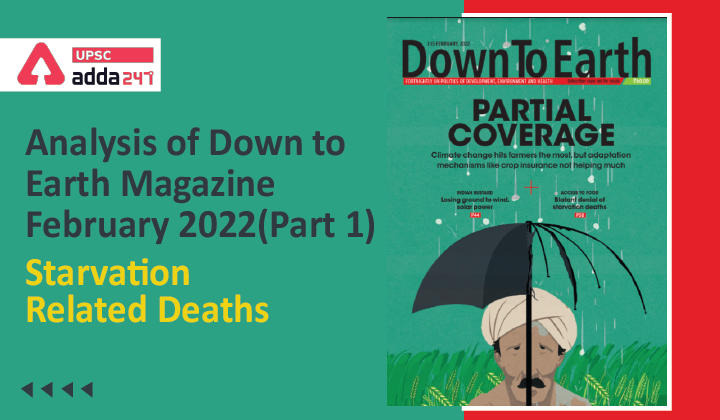Table of Contents
Starvation Related Deaths
Relevance
”GS 2 & GS 3: Government Policies & Interventions, Issues Arising Out of Design & Implementation of Policies, Health, Issues Relating to Poverty & Hunger, Important International Institutions, Food Security”
Introduction
- The government informed the Apex Court that there have been no starvation deaths in the country during recent times, even during adverse situations like the pandemic.
- But the data shows that pandemic revealed the bitter reality of hunger and poverty in India. Even before the pandemic, malnutrition and child deaths were haunting the country.
- It’s strange that India does not shy away from admitting high incidences of poverty and hunger, but its reaction to starvation deaths has always been denial.
NHRC on Starvation Related Deaths
- Since mid-1990’s KalahandiBalangir-Koraput (kbk) region of Odisha reported hundreds of starvation deaths.
- In 2011, a large number of such reports from the region forced the National Human Rights Commission (NHRC) to hold its first full bench outside Delhi—in Odisha.
- Its verdict on the state government’s denial of starvation deaths of 12 children, can shed some light on the ongoing debate. nhrc said starvation might not be the “immediate reason” for the deaths of the children, but the “pattern did suggest to the prevalence of a larger rot in the nutritional security of the district”.
- Earlier also, reacting to starvation deaths in kbk region, it had said: deprivation, hunger and poverty all conspire one to reach to a level of starvation that ultimately kills.
- NHRC had thus recommended measures such as free kitchens, soil and moisture conservation programme, employment assurance schemes and also elaborate health infrastructure.
What do Data say?
- According to the State of Food Security and Nutrition in the World (SOFI) report, between 2014 and 2019, food insecurity increased by 3.8 per cent in India. By 2019, 6.2 crore more people were living with food insecurity than in 2014.
- Also, India accounted for 22 per cent of the global burden of food insecurity, the highest for any country in 2017-19.
- As per the National Family Health Survey (NFHS) report (2015-16), 50.4 per cent of pregnant women were anaemic.
About 8.8 lakh children under five years died in 2018 in our country (The State of the World’s Children report-2019, UNICEF). This report pointed out that malnutrition is the cause of 69 per cent of under-five deaths. - The Global Hunger Index 2021 showed that India slipped to 101 among 116 countries, from the 94th position in 2020. We were placed lower than Pakistan, Bangladesh and Nepal.
What NITI Aayog Says?
- Poverty, hunger and malnutrition are interrelated; often, one leads to another.
- In December last year, the NITI Aayog released an index, which used health, education and standard of living as indicators to gauge the poverty level and its intensity.
- It says 25.01 per cent of India’s population suffer from multidimensional poverty.
- Under the health indicator, nutrition, child mortality and maternal health were used as sub-indicators, as they have an umbilical relationship with hunger and poverty.
What does NSSO’S Survey say?
- The National Sample Survey Organisation’s 66th survey in 2013 also highlighted the prevalence of hunger in India.
- For instance, it said, almost 1 per cent of the rural population did not get two square meals a day some months of the year; the figure is more than twice for farm labourers.
Why governments do not accept the reality of people dying of starvation?
- This is because starvation deaths reflect the failure of the government to protect the most fundamental right—the right to life.
- They reflect the failure of expansive welfare measures, ostensibly taken up to eradicate poverty, hunger and malnutrition.
- India has faced millions of starvation deaths in the past due to drought and famine.
- Those were always attributed to the colonial rulers. It is said that famines vanished with the descent of democracy. So, even a few starvation deaths have that power to paint an elected government in colonial hues.



 TSPSC Group 1 Question Paper 2024, Downl...
TSPSC Group 1 Question Paper 2024, Downl...
 TSPSC Group 1 Answer key 2024 Out, Downl...
TSPSC Group 1 Answer key 2024 Out, Downl...
 UPSC Prelims 2024 Question Paper, Downlo...
UPSC Prelims 2024 Question Paper, Downlo...
